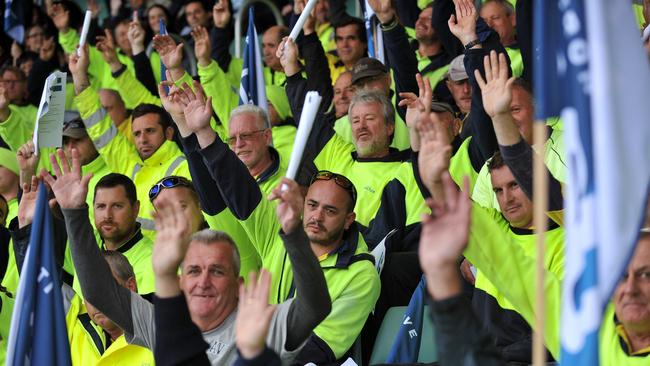
Australia’s wage-price index rose 0.8 per cent in the fourth quarter from the prior quarter, falling short of an expected increase of 1.0 per cent. The WPI rose 3.3 per cent from a year earlier.
The numbers confirm that pressures around wage negotiations in Australia remain largely contained, preventing, for now, the kind of wage increases in countries such as the US, Canada, the UK and New Zealand.
The wage data was a reminder of what is different about Australia. If wages remain contained, it could mean interest rates won’t have to be raised as high as those in other major economies.
Australia’s secret weapon in the war on inflation is the degree to which wage increases are negotiated under collective agreements.
The number is around 60 per cent of all wage contracts, compared with something closer to 11 per cent in the US and 27 per cent in the UK, according to research by JPMorgan.
Those collective wage contracts, which come under the banner of enterprise-bargaining agreements and base-pay agreements known as awards, have an average duration of three years.
So, as Australia fights off the biggest inflation threat in a generation, there is a good chance that the long-term nature of the collective wage agreements will temper wage demands through the worst of the surge in living costs.
Reserve Bank governor Philip Lowe has been keen to highlight this difference, saying publicly that wage earners will have to shoulder some of the burden in fighting inflation by accepting for a time that wages won’t rise at the same speed as inflation.
If that happens, Dr Lowe has warned that the scourge of inflation will be felt more profoundly through much higher interest rates over time.
Australia’s inflation rate was an annual 7.8 per cent in the fourth quarter, a 32-year high. The RBA is hopeful that the quarter marked the peak in inflation, but it is also quick to add that it has no concrete evidence of that just yet.
Wages continue to rise in Australia at a rate the RBA will still feel is too strong.
So the fourth-quarter data wasn’t a eureka moment for the central bank, and there won’t be any backing away from the hawkish stance it adopted at the start of this month.
A few more interest-rate increases can still be expected in March and April.
Longer term, there is also the chance that Australian wage agreements will be no different from the rest of the world. Australia might just be lagging behind rather than outperforming other economies.
But given that the unemployment rate remains close to a 50-year low and that the job market has been ultra-tight for some time, the weaker-than-expected wage growth in the fourth quarter was good news for those acting to cool off the inflation threat.
Dow Jones newswires




Australia’s soft wage-growth data this week has kept alive the idea that the resource-rich economy may yet be different from the rest of the world in its ability to fight roaring inflation.